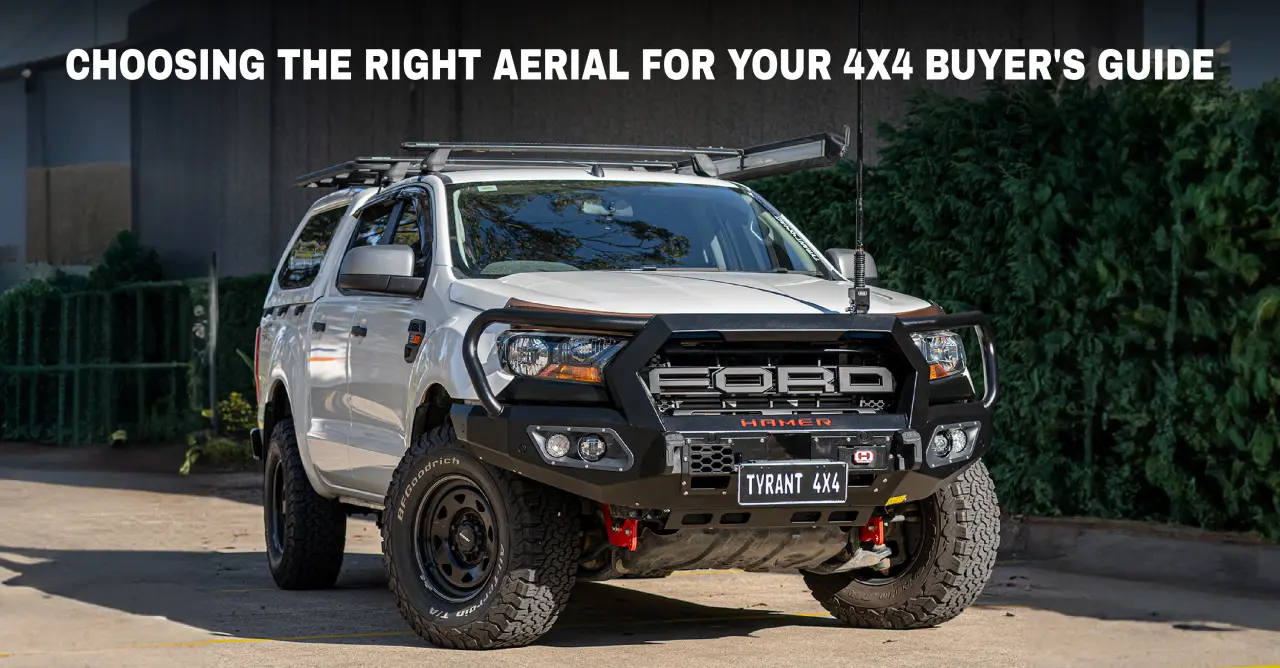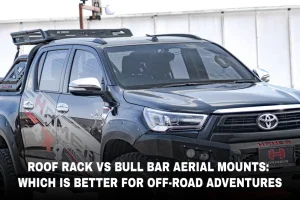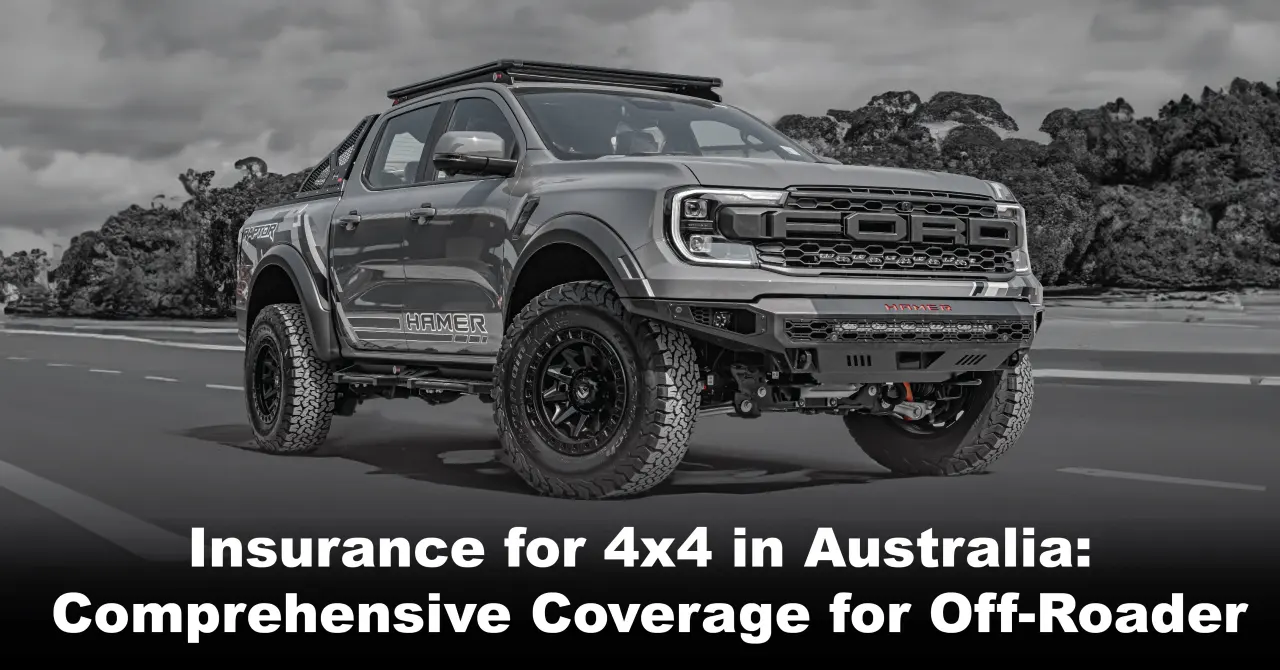NEWS & ACTIVITY
Choosing The Right Aerial for Your 4×4 Buyer’s Guide
If you’re an avid 4×4 adventurer in Australia, you know the importance of staying connected and navigating effectively in the vast and sometimes challenging terrains of the Australian outback. One key component that can make or break your off-road experience is the choice of the right aerial (or right antenna) for your 4×4 vehicle. In this comprehensive buyer’s guide, we will delve into the factors that matter most when selecting the ideal aerial for your Australian 4×4 adventures.
Understanding the Different Types of Aerials
Medium Gain Antenna Explained
A medium gain antenna is a versatile solution that strikes an equilibrium between range and size. It is designed to cater to the needs of 4×4 enthusiasts exploring a variety of terrains in Australia.
Advantages of Medium Gain Antenna
-
Versatility: Medium gain antennas are adaptable and well-suited for a range of terrains, from flat expanses to moderately hilly landscapes.
-
Adequate Range: They offer a reasonable range for communication and navigation, ensuring you stay connected and informed during your off-road excursions.
-
Compact Size: Compared to high-gain antennas, their relatively smaller size makes them less conspicuous and easier to mount on different parts of your vehicle.
Disadvantages:
-
Limited Range: While medium gain antennas provide a reasonable range, they might not be suitable for very remote or extremely hilly terrains where extended range is crucial.
-
Signal Quality: In challenging conditions with obstacles or interference, medium gain antennas may not offer the same signal quality as high gain antennas.
High Gain Antenna
A high gain antenna is engineered to provide an extended range and improved signal quality, making it the go-to choice for 4×4 enthusiasts exploring remote and hilly terrains in Australia.
Advantages
-
Extended Range: these antennas excel in offering an extended communication and navigation range, crucial for off-roaders traversing remote areas.
-
Improved Signal Quality: They are known for delivering superior signal quality, ensuring clear and reliable communication, even in challenging conditions.
-
Rugged Performance: High gain antennas are built to endure rugged environments, making them a dependable choice for off-road adventures.
Disadvantages:
-
Larger Size: These antennas are often larger and more conspicuous due to their longer elements and design. This can make mounting them on your vehicle more challenging.
-
Overkill for Some Scenarios: In relatively flat and open terrains, these antennas might be excessive, and their larger size can be a drawback.
UHF Antenna
A UHF antenna is an indispensable component for off-road communication in Australia, where UHF radios are commonly utilized. These networks enable effective short to medium-range communication.
Advantages
-
Network Compatibility: UHF antennas are tailored to work seamlessly with the UHF radio networks prevalent in Australia. They ensure that you can communicate with others in your group and access emergency services.
-
Effective Communication: UHF antennas are highly efficient for short to medium-range communication, which is often sufficient for 4×4 adventures in Australia.
-
Regulatory Compliance: Utilizing UHF antennas ensures compliance with Australian regulations, making them a legal and practical choice for off-roaders.
Disadvantages:
-
Limited Range: UHF antennas are not designed for long-distance communication, so they might not be suitable for extremely remote areas.
-
Terrain Dependency: While they work well in most terrains, very hilly or heavily forested areas may still pose challenges for UHF communication.
Magnetic Antennas
These antennas are designed for ease of installation and removal. They are equipped with a magnetized base that adheres to the vehicle’s metal surface, eliminating the need for drilling or permanent mounting.
Advantages
-
Convenience: Magnetic antennas are incredibly convenient, allowing for quick and hassle-free installation and removal.
-
No Drilling Required: They eliminate the need to drill holes in your vehicle, which some 4×4 enthusiasts prefer to avoid.
Disadvantages:
-
Stability: Magnetic antennas have limited stability, particularly in rugged terrains or at higher speeds. They may come loose or shift position, affecting performance.
-
Limited Range and Signal Quality: Due to their temporary and less secure mounting, these antennas may not provide the same range and signal quality as permanent installations.
Factors to Consider When Choosing a Right Antenna
When selecting an aerial for your 4×4, several factors come into play:
-
Terrain and Environment: Australian terrains can vary from flat and open to hilly and dense. Your choice of aerial should align with the specific terrain you’ll be traversing.
-
Antenna Gain: Consider the gain of the antenna, which directly impacts signal strength and range. High gain antennas are suitable for remote areas, while medium gain antennas are more versatile.
-
Compatibility with Australian Networks: Ensure your aerial operates on the frequencies used in Australia, particularly if you’re exploring remote regions.
-
Mounting Options: Explore different mounting options like roof mounts, bull bar mounts, and rear bumper mounts, depending on your vehicle and requirements.
Assessing Your 4×4 Adventure Needs
You might need to ask yourself these questions to understand your need and to help you to choose the right gear.
Q: Are you planning to explore the flat terrains of the Australian outback or tackle rugged, hilly country?
A: A medium gain antenna may suffice if your 4×4 adventures lean towards flat terrain(s) in the Australian outback.
On the other hand, if you intend to tackle rugged and hilly terrain, especially in remote areas, a high gain antenna might be the better choice due to its extended range and improved signal quality.
Q: Do you require a broad signal pattern to cover a large area, or a more focused signal for communication in a straight, narrow path?
A: If you often find yourself in situations where you need to communicate over a broad area, such as when traveling with a group, a high gain antenna with a broad signal pattern could be advantageous.
Conversely, if you navigate through straight, narrow paths where pinpoint communication is vital, a more focused signal from a medium gain antenna may be the preferred option.
Q: What is the level of mobile coverage in your chosen adventure locations?
A: If you anticipate good mobile coverage in most of your adventure locations, it might influence your antenna choice. However, if you frequent remote areas with limited mobile coverage, having a reliable antenna, such as a UHF antenna, becomes even more critical for staying connected in those challenging environments.
Installation and Maintenance Tips
Once you’ve chosen the right aerial, proper installation and maintenance are key to optimal performance. Here are some tips:
-
Secure Mounting
-
Location Matters: Choose the right mounting spot for your antenna, whether it’s on the roof, bull bar, or rear bumper, based on your vehicle type and preferences.
-
Solid Attachment: Securely fasten the antenna to its mounting point using appropriate hardware, brackets, and fasteners to prevent movement during off-road journeys.
-
Grounding Connection: If grounding is necessary, connect your antenna to an appropriate grounding point on your vehicle. Proper grounding enhances signal quality and safety.
-
-
Cable Routing
-
Plan Your Route: Carefully plan the route for the coaxial cable from the antenna to inside your vehicle, ensuring it’s secured and protected from potential damage, like sharp edges or extreme heat.
-
Waterproof Connections: Seal all cable connections with waterproof materials, such as silicone tape or heat-shrink tubing, to prevent moisture from compromising signal quality or causing damage.
-
-
Routine Inspection and Maintenance
-
Visual Checks: Periodically inspect your antenna for visible damage, loose parts, or signs of wear and tear. Pay close attention to the mounting hardware and ensure it remains securely fastened.
-
Keep it Clean: Regularly clean the antenna’s exterior to remove dirt, dust, and debris, which can accumulate over time. A clean antenna performs better and enjoys a longer lifespan.
-
Anti-Corrosion Protection: If your adventures take you to coastal or salty environments, consider applying an anti-corrosion coating to the antenna and its components to safeguard against rust and deterioration.
-
-
Proper Tuning
-
SWR Check: Use an SWR meter to measure antenna’s ability to direct or concentrate radio frequency energy in a particular pattern or direction. Adjust its length or tuning elements as needed to achieve an optimal SWR reading, ensuring maximum signal efficiency.
-
-
Secure Loose Elements
-
Tighten as Needed: If you identify loose elements, such as screws or connections, during your inspections, promptly tighten them to maintain stable performance.
-
-
Minimize Interference
-
Interference Prevention: To avoid interference from nearby metal objects or electrical components, ensure your antenna is properly insulated and positioned away from potential sources of interference.
-
Budget Considerations
When choosing an aerial for your 4×4 adventures, budget considerations are essential. However, it’s crucial not to compromise on quality. You can find budget-friendly options like medium gain and UHF antennas. Reputable brands like Hamer 4×4 offer reliable and affordable choices.
To strike the right balance, assess your needs, research options, and compare prices. Remember that investing in a quality antenna is an investment in your off-road safety and connectivity, providing long-term value for your adventures.
Conclusion
In conclusion, choosing the right aerial for your Australian 4×4 adventures is crucial for optimal off-road experiences. Your options include Medium Gain Antennas, versatile and suitable for various terrains, and High Gain Antennas, ideal for remote and challenging terrains with extended range and superior signal quality. UHF Antennas are essential for reliable communication in Australia, while Magnetic Antennas offer temporary convenience. Consider terrain, signal pattern, and mobile coverage when selecting your aerial, and ensure proper installation and maintenance for optimal performance.
Choose wisely to enhance your 4×4 adventures in the rugged terrains of the Australian outback. Follow us on Facebook: Hameroffroad to get newsletter and promotions!











































































































